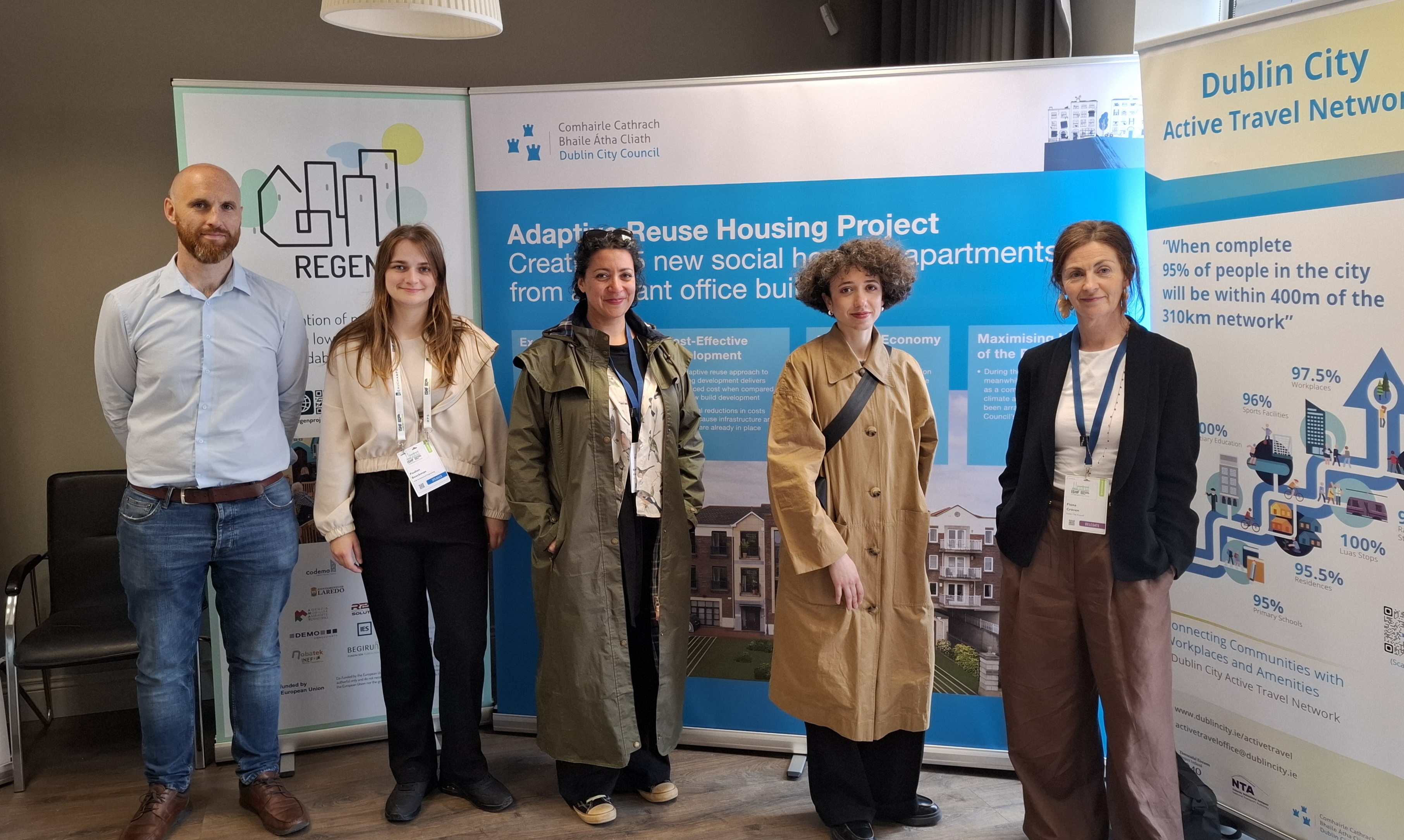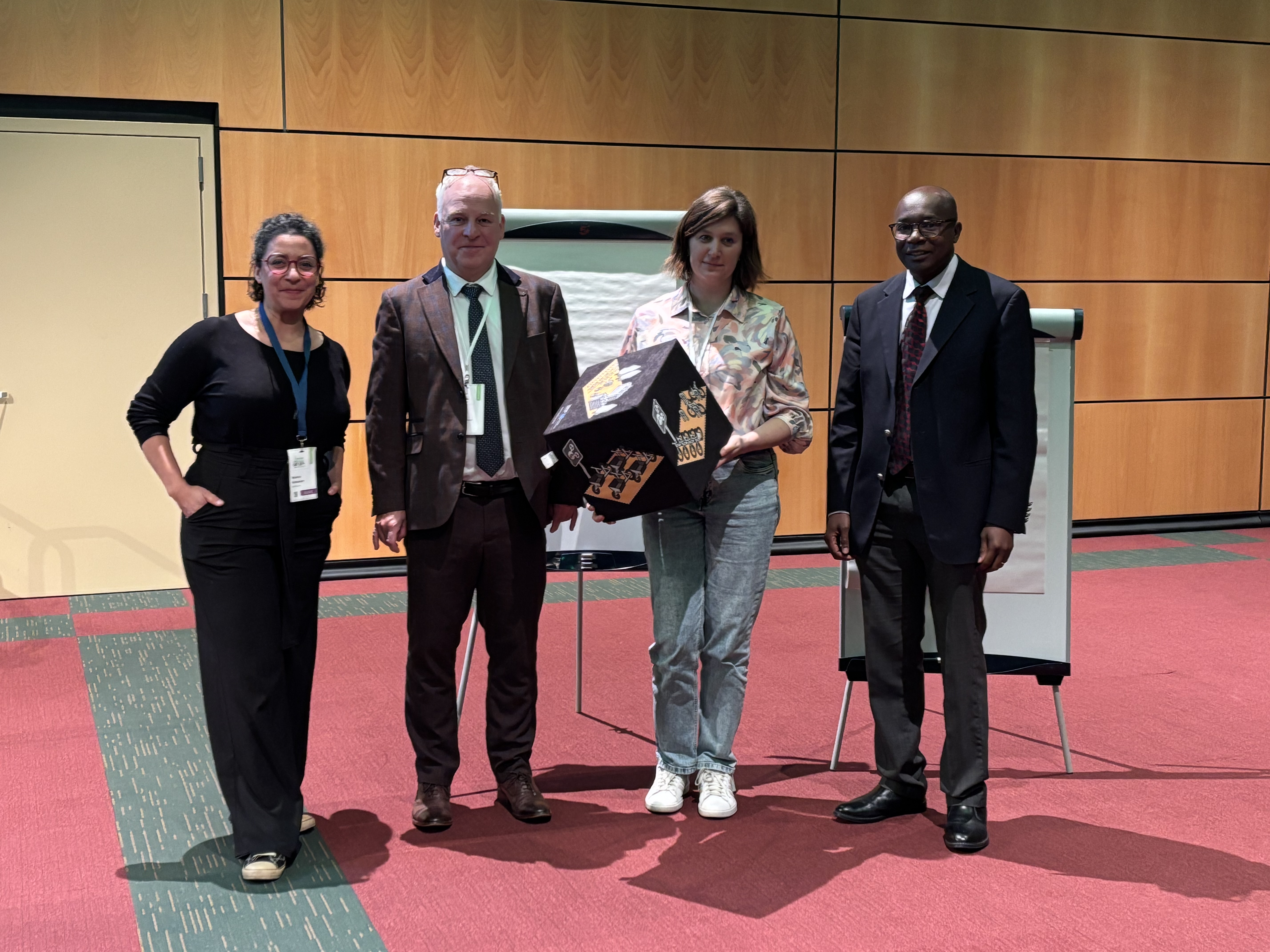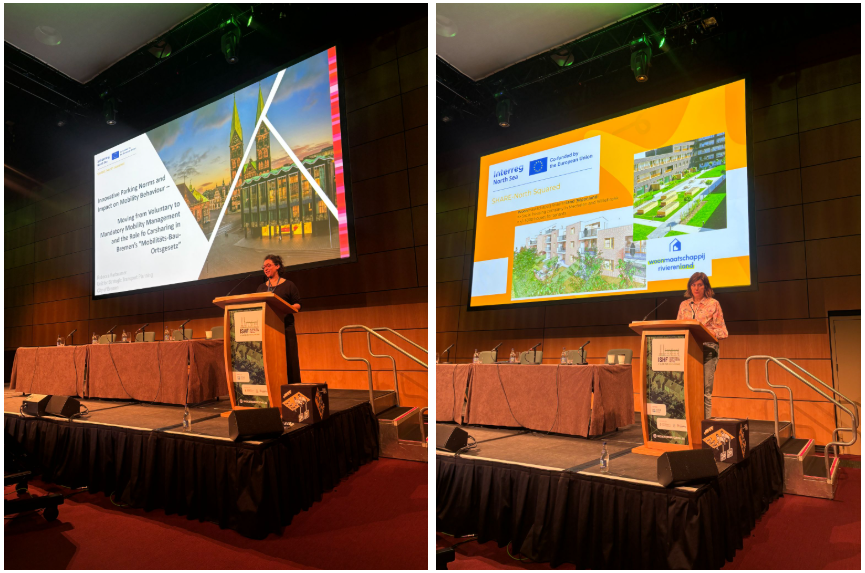Rebecca Karbaumer (Freie Hansestadt Bremen) and Clara Mafé (Housing Europe) represented the SHARE-North Squared project at the International Social Housing Festival 2025 in Dublin. In this article, you can read all about the sessions they hosted, and how the Dublin City Council and the South Dublin County Council are integrating shared mobility into their social housing projects.
SN² inspires in Dublin
The 2025 edition of International Social Housing Festival, the biannual gathering of public, cooperative and social housing providers across the globe was organised by Housing Europe and hosted at the Convention Centre Dublin by Irish Council for Social Housing and Co-operative Housing Ireland. With our partners, SHARE-North Squared brought the new mobility paradigm to the program.
We introduced policy and practical solutions on how shared mobility can serve as a powerful tool for social inclusion, climate action, and affordable housing. Our two-day participation featured interactive workshops, site visits, and a high-level roundtable, all highlighting the critical link between mobility and equity in urban development.

SHARE-North Squared and our local connections introduced shared mobility as a a chapter in the affordable housing playbook.
The ABC of shared mobility
During our opening session on June 5, 'Shared Mobility for Dummies', hosted by Rebecca Karbaumer (City of Bremen) and Clara Mafé (Housing Europe), attendees learned about the basics and benefits of shared mobility. These included car sharing, bike sharing, ride sharing, and shared public space - all designed to reduce private car dependency and promote healthier, more sustainable urban lifestyles.
We highlighted why we believe shared mobility is an interesting option for (social) housing providers, namely:
Cost-efficiency: Reduces the need for expensive parking infrastructure;
Decarbonisation: Fewer cars mean less pollution and healthier environments;
Spatial justice: Bridges the gap between underserved communities and urban opportunities.
Specifically, car sharing has shown dramatic reductions in car ownership and usage, while bike sharing supports first- and last-mile connectivity. Micro mobility solutions like e-scooters fill gaps in traditional transit networks, and shared spaces reclaim urban areas for people and green infrastructure.
However, there are still barriers, including regulatory inertia, digital divides, and cultural preferences for car ownership. Underground parking mandates, affordability issues, and failed pilot programs have also hindered progress.
A new mobility paradigm?
On the second day of the conference, our session 'Unlocking the Potential of Shared Mobility for Social and Affordable Housing', introduced best practices from the City of Bremen and Mechelen-based social housing provider Woonland. It opened a roundtable discussion with local authorities in Dublin to explore the potential of new forms of mobility in social housing.
Mister Christopher K. Manzira, Acting Director of Dublin City Council’s (DCC) Active Travel Program, provided a compelling picture of how shared and active mobility, when integrated with housing policy and urban design, can help tackle transport poverty, reduce car dependency, and create more equitable access to the city for all residents, particularly those in social and affordable housing. The Council’s initiatives are related to:
Active Travel Infrastructure: The DCC is developing a comprehensive Active Travel Network (targeting 314 km), aimed at improving access to walking, wheeling, and cycling routes across the city. This directly supports low-income and car-free households in social housing by offering affordable and sustainable mobility options.
Shared Micro Mobility: The city supports three major shared bike schemes, namely DublinBikes, Bleeper, and Moby Bikes. They serve as first- and last-mile solutions, especially important in areas not well-served by public transport. The three services help bridge the transport gap for social housing residents with limited mobility options.
Transport Poverty: The DCC acknowledges the socio-economic divide in mobility, with lower-income groups being less likely to walk or cycle regularly and often lack access to the concept of “active travel.” The council is actively working to address this through inclusive design and community outreach, ensuring social housing tenants are not left behind.
Design for Equity: Historical references like the Marino Estate, which featured built-in bicycle and pram space, are now inspiring modern planning principles that embed mobility needs directly into housing design — creating safer, more accessible environments for vulnerable residents.

Rebecca Karbaumer, John Joe Hegarty, Katrien Van Moer and Christopher K. Manzira discussed shared mobility solutions tailored to social housing.
Mister John Joe Hegarty, Senior Engineer at South Dublin County Council (SDCC), offered a strategic and systems-level perspective on embedding mobility innovation into transit-oriented development.
In SDCC’s vision, transit-oriented development is about planning compact, mixed-use developments where housing is seamlessly integrated with public transport, walking, and cycling. But crucially, this vision also includes reducing car parking requirements and promoting shared mobility as a viable alternative.
The South Dublin County Council's vision includes reducing car parking requirements and promoting shared mobility as a viable alternative.
Through its Mobility Management Plan requirements, every private and public housing development must now consider how to facilitate shared transport, such as car clubs, within its footprint. This is a deliberate effort to avoid locking in car dependency at the planning stage.
For example, in projects like Clonburris Strategic Development Zone and City Edge, SDCC is designing collective parking blocks that can eventually be phased out or repurposed, paving the way for zero-parking or low-parking housing. In tandem, shared mobility hubs and improved public transport links (like BusConnects and DART+ Southwest) support behaviour change.
To conclude, mister Hegarty highlighted that each shared car can replace up to 20 private vehicles, freeing up space for greenery, play areas, or additional housing. For vulnerable groups, enhanced pedestrian safety and cycling infrastructure also create healthier, more inclusive communities.
A shared vision on sharing
Both Dublin City Council and South Dublin County Council stressed that shared mobility must be complementary to strong public transport and are not a substitute. They see shared cars, bikes, and e-scooters as essential tools to reduce parking pressure, enable more affordable housing, and support more liveable neighbourhoods. This is in line with the SN² principles, which call for:
Rebalancing parking norms with mobility investments.
Starting small with shared fleets but planning for scale.
Engaging residents early and consistently.
Making shared vehicles visible and easy to access.
Despite cultural attachment to car ownership and the digital divide among some resident groups, both councils are committed to removing barriers through pilot projects, subsidies, or awareness campaigns. They demonstrate that shared mobility is not just for the tech-savvy or affluent, but for everyone.

Rebecca Karbaumer and Katrien Van Moer taking the stage to present some learnings from Bremen and Woonland social housing in Mechelen.
Concept to practice: Fitzwilliam Quay
Finally, we visited Fitzwilliam Quay in Ringsend, Dublin 4, where we were guided by Fiona Craven. She is the Programme Manager at Dublin City Council and introduced an ambitious adaptive reuse project that exemplifies sustainable urban redevelopment. The initiative involves the conversion of an existing office building into 15 high-quality apartments, responding to housing needs while minimising environmental impact.
Located in a designated Decarbonisation Zone, the development is poised to become a model of climate-conscious housing. As part of the transformation, the existing car park will be de-paved and replaced with a shared garden space, including secure bike and e-bike storage for residents. Plans also include the integration of a shared car facility, further encouraging low-carbon mobility choices.
Fitzwilliam Quay is poised to become a model of climate-conscious housing.
The site is particularly well-served by public transport and sits just 200 metres from a public bike share station. It also benefits from excellent connectivity to the city via a proposed greenway along the River Dodder, which will run directly in front of the development—making active and shared travel practical and attractive for future residents.
The building has already been acquired by the City Council, with a design team currently being appointed. Construction is scheduled to begin in early 2026, setting in motion a project that aligns housing delivery with sustainability, liveability, and community-focused design.
Credits
Text and pictures by Clara Mafé (Housing Europe)
Edited by Jelten Baguet (Mpact)
